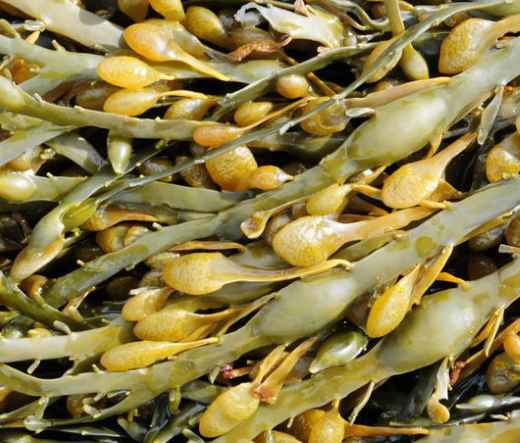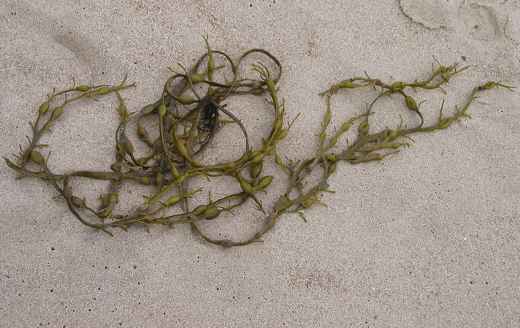Ascophyllum nodosum or knotted wrack
This is a very common seaweed on rocky shores in North of Europe and Canada. The species has two meter long fronds with large yellow egg-shaped air bladders at regular intervals. The fronds are attached to rocks in the mid-littoral where it is often the most dominant species in the littoral zone. It can also be found on breakwaters and jetties.
Ascophyllum nodosum supports the growth and gives shelter for a large amount of snails, shrimps, fishes and mussels, periwinckles etc.

Norwegian kelp or rockweed or Ascophyllum nodosum has large yellow egg-shaped air-bladders, hence its common name egg wrack.

During a storm large amounts of knotted wrack will break of from its base. Free floating fronds can survive in the sea for long times and be found on the sandy beaches.

Polysiphonia lanosa is an epiphyte of Ascophyllum nodosum (rockweed, Norwegian kelp) and sometimes on other seaweeds or fucoids. Polysiphonia and the rockweed can be found on on the mid-littoral of rocky shores around the Britisch Islands and the French coast. Rockweed is a very common seaweed and so is Polysiphonia lanosa. They can both be found on beaches sometimes entangled in the nets of fishery. Rockweed can be found on the coast of north-western Europe and the north-eastern coast of North America. Polysiphonia is less resistant to dehydration than its host Ascophyllum, and will not be found in knotted wrack that can be found in the upper parts of the splash zone.
knotted wrack reproduction
A. nodosum is a sexually reproducing seaweed, eggs are produced in the greenish receptables, they are fertilized by the
sperms that are produced in the yellow receptables.
Ascophyllum nodosum can grow from either sexual recruits or by vegetative propagation
Because sexual reproduction is limited in natural populations, vegetative propagation is the most important component of natality.

Seaweed of the European shores.(British schoolplate of 1930)
1 fucus vesiculosus or bladder wrack
2 Corraline algae
3 irish moss or carageen moss or Chondrus crispus
4 Rhodophyllis divaricata or rhodimenia bifida
5 serrated wrack
6 Zostera marina
7 tangle or ribbonweed
8 knotted wrack
9 Sea lettuce
10 ectocarpus siliculosus
11 Lomentaria articulata
12 polysiphonia urculata
13 cordweed or bootlace weed
14 Plocamium coccineum
15 Cladophora rupestris
16 dulse
